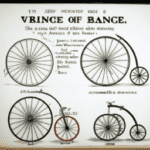Bicycle aesthetics have shifted from early wooden, horse-inspired frames to sleek, modern designs featuring high-tech materials like carbon fiber and integrated electronics. The high wheel era emphasized size and speed, while the safety bicycle introduced smaller, balanced shapes for everyday use. Today, innovations focus on aerodynamics, customizable styles, and eco-friendly materials. If you explore further, you’ll discover how technological advances continue to shape your bike’s look and feel for the future.
Key Takeaways
- Early bicycles featured wooden frames and horseback-inspired curves, emphasizing lightweight design and ergonomic aesthetics.
- The high wheel era prioritized large front wheels for speed, but safety concerns led to the development of smaller, balanced safety bikes.
- The introduction of the diamond frame and chain drive by John Kemp Starley marked a shift toward modern, functional bicycle aesthetics.
- Contemporary designs focus on aerodynamic shapes, integrated components, and innovative materials like carbon fiber and recycled composites.
- Future trends include customizable, tech-integrated bikes with dynamic finishes, smart features, and sustainable, eco-friendly materials.
Early Wooden Frames and Horse-Inspired Designs
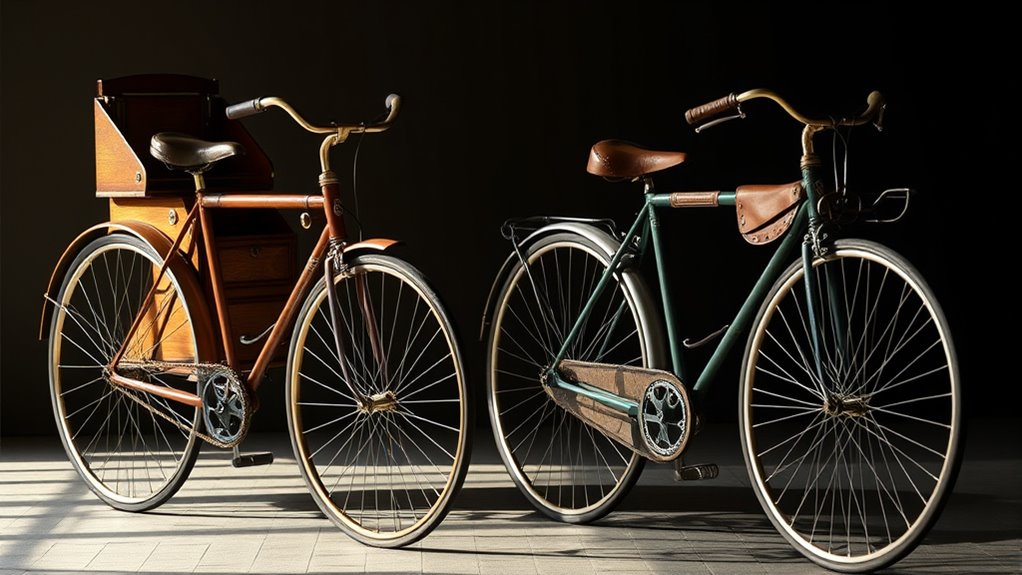
Early wooden bicycle frames marked a significant step in the evolution of cycling design, combining craftsmanship with innovative engineering. You’ll notice they used hardwoods like Michigan rock elm or laminated wood, reinforced with steel rods for strength. To prevent splitting at joints, steel triangles or screws were added, and metal straps reinforced bamboo-to-hardwood connections. Innovators such as Eberhard Cycle Co. developed laminated wood frames with embedded steel, tackling challenges like durability and stress. These frames laid the groundwork for modern wooden and bamboo bikes, benefiting from advances in adhesives and fabrication. The design mimicked horseback riding, earning nicknames like “hobby-horses” and “dandy horses.” Its serpentine curves and equestrian-inspired ergonomics made it a fashionable yet short-lived trend, reflecting a blend of craftsmanship and cultural influence. Additionally, the use of lightweight materials contributed to improved performance and maneuverability in early bicycle designs. The integration of innovative engineering techniques helped these early models withstand the stresses of riding and paved the way for future advancements in bicycle aesthetics. Moreover, the development of remote collaboration tools during modern times has significantly impacted the design process by enabling global teams to innovate together remotely. Furthermore, these pioneering designs influenced contemporary aesthetic preferences, blending function with art. Recognizing the importance of material innovation has driven ongoing improvements in bicycle frame construction, shaping the diverse styles seen today.
The Pedal Revolution and the Rise of the Velocipede

The invention of pedals marked a turning point in bicycle history, transforming wooden velocipedes into more efficient and accessible machines. Before pedals, the Draisine relied on riders pushing off the ground, limiting speed and control.
Around 1853, Philipp Moritz Fischer introduced pedal cranks, revolutionizing propulsion. Early velocipedes, with pedals attached to the front wheel, gained popularity across Europe and North America, thanks to their improved usability.
Michaux and Lallement contributed to refining pedal placement, making riding more practical. These developments led to stronger materials, metal frames, better wheels, and enhanced brakes, boosting durability and safety.
The velocipede’s rise made cycling more appealing and affordable, laying the groundwork for future innovations. As its popularity grew, cities began regulating its use, reflecting its increasing societal impact. Rustic charm and classic design elements have continued to influence modern bicycle aesthetics, blending vintage appeal with contemporary functionality.
The High Wheel Era and Its Cultural Impact
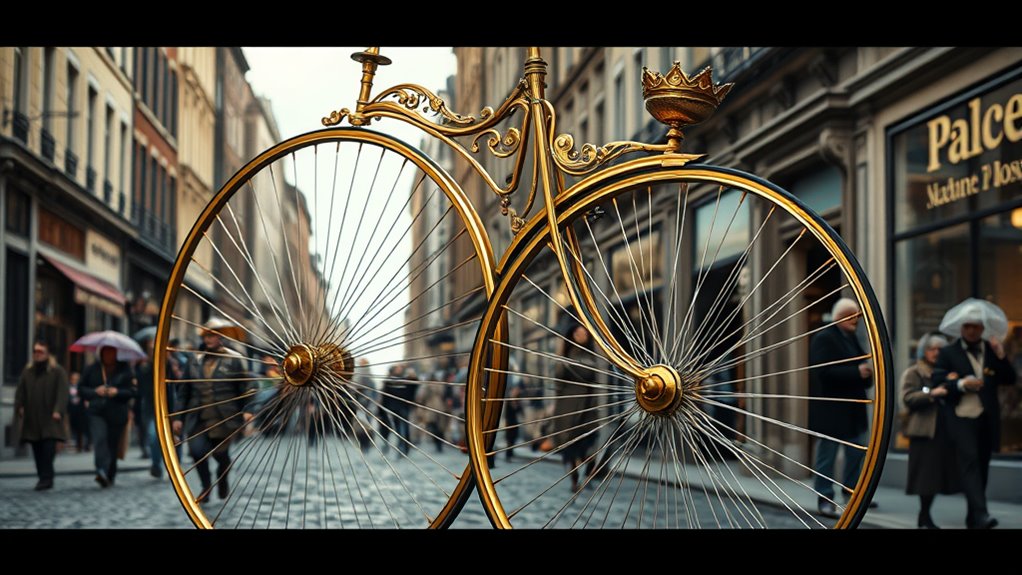
During the High Wheel Era, bicycles became symbols of social status and technological innovation, capturing public imagination across Europe and North America. You’d see the elite riding these tall machines, which showcased cutting-edge engineering like wire-spoke wheels and lightweight steel frames.
The large front wheels, some up to 60 inches, boosted speed but also increased safety risks, like headers and falls. Innovations such as “Moustache” handlebars improved control, while custom sizing and complex gear systems made bicycles a form of conspicuous consumption.
Riding a high wheel elevated your social prestige, especially since riding skills and access were limited. Cycling events and racing culture fueled public interest, and the era’s design innovations influenced future safety bicycles, leaving a lasting mark on transportation and societal perceptions of mobility. Researching bicycle safety can provide insights into how these early designs impacted modern standards.
The Birth of the Modern Safety Bicycle
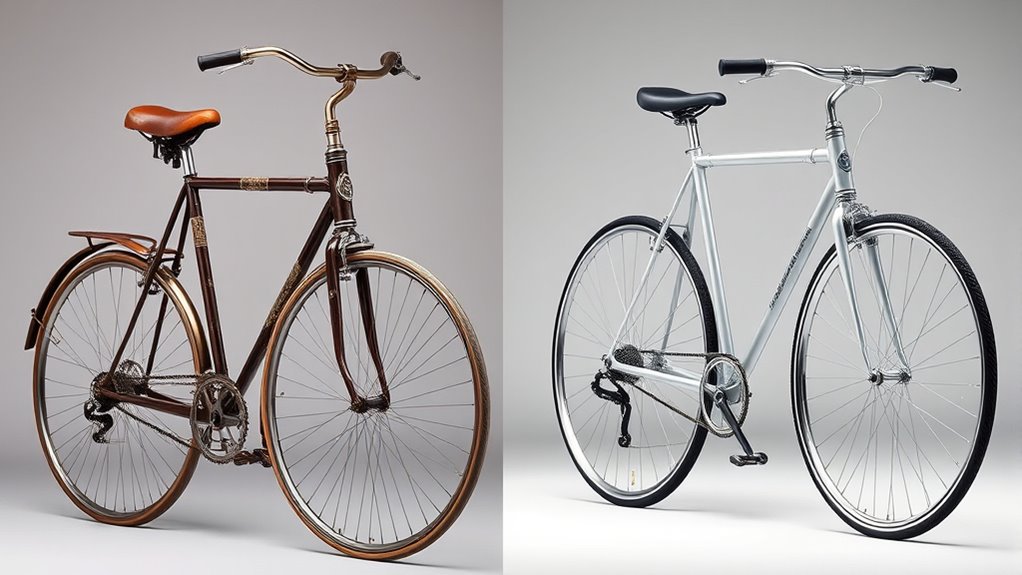
As bicycle enthusiasts sought safer and more practical designs after the high wheel era, inventors began experimenting with different configurations to improve stability and accessibility. Early safety bicycles, like Henry Lawson’s 1876 model, introduced treadles and chain drives but failed commercially due to complexity and cost. The development of water-resistant materials in bicycle components helped enhance durability and performance, making bicycles more practical for everyday use. Predecessors such as Thomas Humber’s 1868 design and dwarf models like the Kangaroo featured smaller wheels and front-chain drives. By 1885, lever front-drives dominated, with chain rear-drives remaining rare. Additionally, the incorporation of precious metals in manufacturing components contributed to the durability and aesthetic appeal of early bicycle models. The shift from indirect to direct steering improved control and safety. John Kemp Starley’s 1885 Rover Safety marked a breakthrough with equal-sized wheels, a chain-driven rear wheel, and a low center of gravity. Its lightweight, diamond frame design became the blueprint for modern bicycles, transforming cycling into a practical, popular transportation mode. The use of water-resistant materials also allowed for more reliable riding in various weather conditions, further boosting bicycle popularity. Furthermore, innovations in aesthetic design helped make bicycles more appealing to a broader audience, fueling their evolution from utilitarian devices to style statements. The integration of modern manufacturing techniques also contributed significantly to mass production and affordability, making bicycles accessible to the general public.
Contemporary Styles and Material Innovations
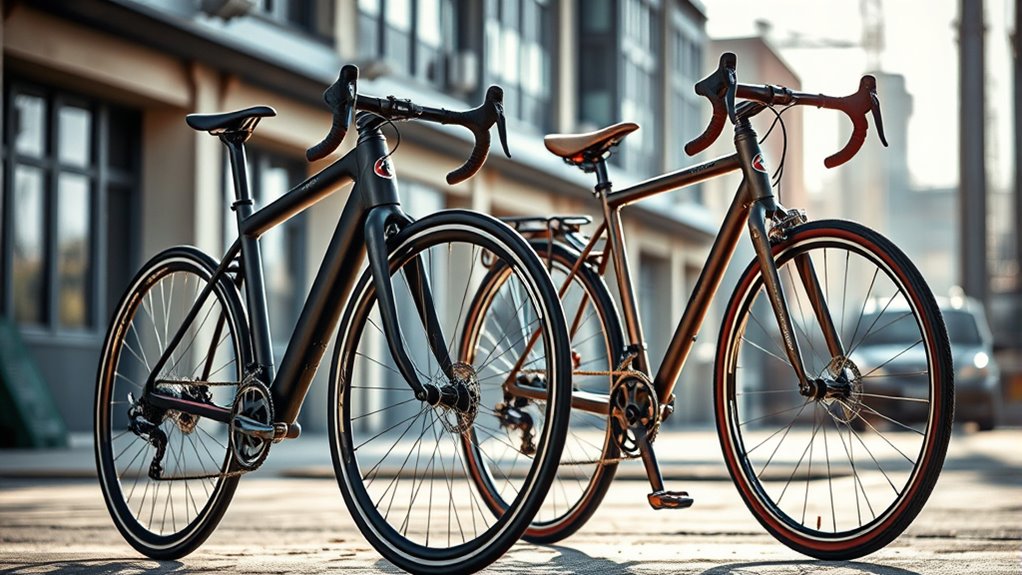
Contemporary bicycle design has embraced both aerodynamic efficiency and innovative materials to enhance performance and rider comfort. You’ll notice wider tire clearances—28 to 32mm—that balance speed and comfort, along with integrated cable routing for a sleek look. The integration of home decoration inspiration into bicycle aesthetics reflects a broader trend of blending form and function. Truncated airfoil tube shapes replace traditional round tubes, improving aerodynamics, while lightweight aero frames blend climbing agility with race prowess. Hidden seatpost clamps and flush components create a clean aesthetic. Material advances include high-modulus carbon fiber dominating performance frames, hybrid builds like carbon forks on aluminum frames for affordability, and recycled carbon fiber for eco-friendliness. Additionally, 3D-printed titanium parts offer tailored fit options, and graphene-infused resins boost durability. The use of advanced materials such as these continues to push the boundaries of bicycle performance and sustainability, with innovations like biodegradable composites gaining interest. These innovations collectively redefine modern bicycles, combining style, efficiency, and sustainability.
The Future of Bicycle Aesthetics and Personalization
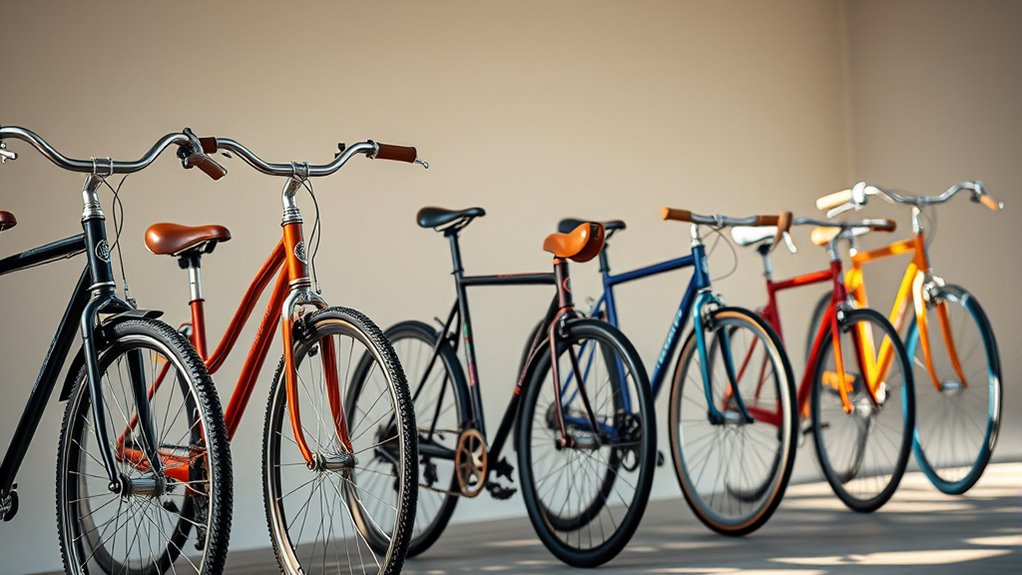
Advancements in technology are transforming bicycle aesthetics and personalization, enabling you to craft bikes that reflect your unique style and functional needs. 3D printing allows for complex, customized designs that make each bike one-of-a-kind, while digital design tools give you precise control over aesthetics and engineering. Predictive analytics can also be utilized to anticipate trends in design preferences, ensuring your custom bike stays ahead of the curve. Additionally, smart frame technology is emerging, embedding sensors and connectivity features into bicycles to enhance functionality without compromising style. Integrated tech like GPS and sensors enhance functionality without compromising style. You can choose from a wide array of colors and designs through digital customization platforms, visualizing your dream bike before it’s built. Emerging trends include compact e-bikes with integrated batteries, color-shifting paints for dynamic looks, and matte finishes for a sleek appearance. Future innovations focus on eco-friendly materials, smart frames with embedded sensors, and collaborative design processes, making bike customization more accessible and tailored than ever before.
Frequently Asked Questions
How Did Early Bicycle Designs Influence Modern Bicycle Frames?
You see how early bicycle designs laid the foundation for modern frames. The shift from wooden and iron structures to lightweight steel, aluminum, and carbon fiber made bikes stronger and easier to handle.
The diamond frame, introduced in 1899, became the standard because of its durability and simplicity. Today, you benefit from these innovations, with advanced materials and geometry that improve comfort, stability, and performance across all types of bicycles.
What Materials Were Used in the Earliest Bicycle Constructions?
You might be surprised to learn that the earliest bicycles were primarily made from wood, with iron-shod wheels adding durability.
As you explore further, you’ll find that around 1870, metal frames, especially iron, became common, making bikes stronger but heavier. Rubber tires later replaced solid ones, improving comfort, while wire-spoked wheels enhanced performance.
These material innovations laid the foundation for the modern, lightweight bicycles you see today.
How Did Cultural Perceptions of Bicycles Change Over Time?
You see, cultural perceptions of bicycles shifted from symbols of practicality and modernity to icons of social change. Initially, they were mainly for men, but as women embraced cycling, attitudes shifted, challenging Victorian norms.
Bicycles became symbols of independence, equality, and even status. Over time, societies either embraced or resisted these changes, reflecting broader cultural debates about gender roles, modesty, and social progress.
These evolving perceptions helped shape how bicycles are viewed today.
What Innovations Most Significantly Impacted Bicycle Aesthetics Today?
Imagine a sleek symphony where every note enhances beauty and function. Today, innovations like integrated components, lightweight materials, and advanced safety tech transform your bike into a masterpiece of design.
Disc brakes, smart sensors, and customizable frames act as brushstrokes, blending style with practicality. These innovations shape your riding experience, making your bike not just a vehicle but a canvas of modern aesthetics, seamlessly merging technology and elegance.
How Do Personalized Bicycles Reflect Individual Style Preferences?
Personalized bicycles show your unique style preferences by letting you customize colors, decals, and components to match your personality. You can choose designs, materials, and ergonomic features that reflect who you are, making your bike a true extension of yourself.
This level of customization not only enhances your riding experience but also showcases your individual taste and identity. Turning your bike into a personal statement on wheels.
Conclusion
As you’ve seen, bicycle aesthetics have evolved alongside society’s needs and innovations. From wooden frames to sleek modern designs, each era reflects a blend of function and style. Notably, today’s focus on personalization hints that future bikes might mirror your unique identity, just as the first wooden frames surprisingly echo those early horse-inspired models. It’s a reminder that, in a way, your bike’s style is always a reflection of history and your personal journey.



